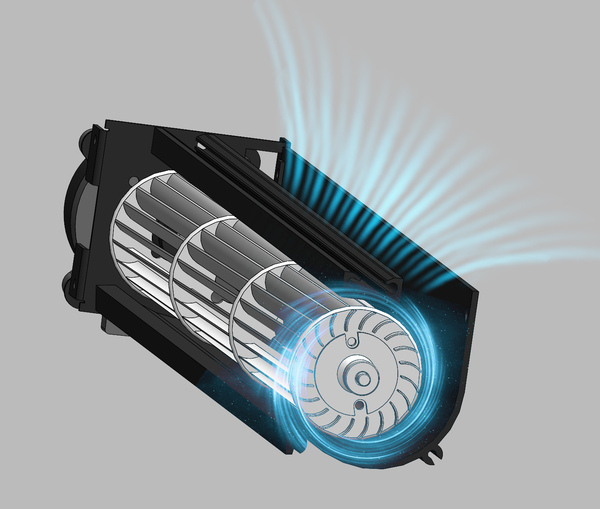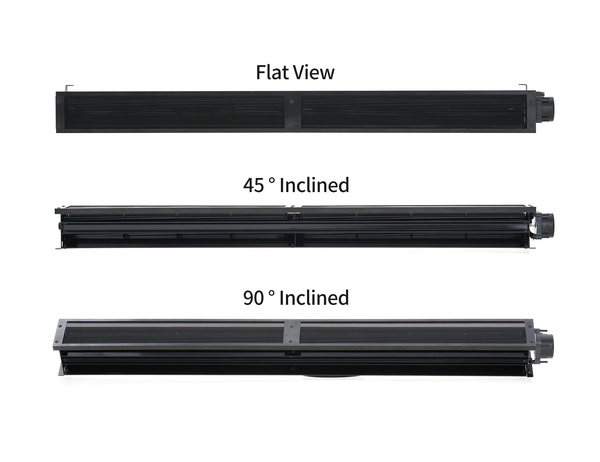All Rights Reserved Privacy Policy Site Map
FOCUS ON EC FAN ONLY
FOCUS ON EC FAN ONLY
Cross flow fan is also called Tangential blower, which was first proposed by French engineer Mortier in 1892. The impeller is multi blade, long cylindrical, and has forward multi wing blades. Its structure is shown in Figure 1. When the impeller rotates, the air flow enters the cascade from the opening of the impeller, passes through the impeller, and is discharged into the volute from the other side of the cascade to form the working air flow. The flow situation of air flow in the impeller is very complex, the air flow velocity field is unstable, and there is also a vortex in the impeller, with the center located near the volute tongue. The existence of vortex makes the output end of the impeller generate circulating flow. Outside the vortex, the flow line inside the impeller is in an arc shape. Therefore, the velocity at each point on the outer circumference of the impeller is inconsistent. The closer to the vortex center, the greater the velocity is. The closer to the vortex shell, the smaller the velocity is. The air velocity and pressure at the fan outlet are not uniform, so the flow coefficient and pressure coefficient of the fan are average values. The position of the vortex has a great influence on the performance of the cross flow fan. The vortex center is close to the inner circumference of the impeller and the volute tongue, so the fan has good performance. If the vortex center is far away from the vortex tongue, the circulation flow area will increase, the fan efficiency will decrease, and the flow instability will increase.

The cross flow fan is mainly composed of impeller, air duct and motor. The impeller is generally made of aluminum alloy or engineering plastics. Aluminum alloy impeller has high strength, lightweight, high-temperature resistance, and can keep stable operation for a long time without deformation; The plastic impeller is made by injection molding and ultrasonic welding. It is generally used in situations with low rotating speed and large diameter.
The air duct is generally formed by stamping metal sheet, or cast with plastic or aluminum alloy. The casing adopts streamline design, which can effectively reduce the loss of air flow and greatly improve the working efficiency of the fan.
The motor is the power part of the cross flow fan, which can be powered by AC or DC. AC power supply mainly includes shaded pole motor and capacitor starting motor, while DC power supply is DC brushless motor. The drive motor is generally flexibly installed with the impeller and fixed on the air duct.
1. The cross flow fan uses a relatively long cylindrical fan impeller to work. The diameter of this cylindrical fan blade is relatively large. Because of the large diameter, it can use a relatively low speed on the basis of ensuring the overall air circulation, thus reducing the noise caused by high-speed operation.
2. The impeller of the fan has been dynamically balanced: just as the wheels of the car need to be dynamically balanced, the wind wheel of the cross flow fan also needs to do this work. In short, it is to maintain the balance of the wind wheel in operation, reduce noise, and extend the life of the fan.
1) The axial length is not limited, and the impeller length can be arbitrarily selected according to different user needs;
2) The airflow flows through the impeller and is affected by the twice force of the blade, so the airflow can reach a long distance;
3) No turbulence and the air outlet is uniform;
4) Because the air flow is forced to turn in the impeller, the head loss is large and the efficiency is low.
*New energy-related products: solar water pump, solar heating, solar photovoltaic inverter, solar cells, heat dissipation of energy storage equipment;
*Cooling and heat dissipation: Stove jacket cooling, electronic machines, dry-type transformers, photocopiers, projectors, computers, etc;
*Ventilation: rooms, public places, vehicles, underfloor convectors,
air doors;
*Industrial machinery: agricultural materials cleaning: constant temperature and drying machinery; Heating and cooling room equipment;
*Household appliances: refrigeration and display cabinets, air conditioning fans (air conditioning fans, building fans, tower fans), air heaters, electric fireplaces, air curtain machines, embedded ovens, wood-burning stoves,air conditioners and storage heaters, etc.

PBM cross flow fans are designed small in size with high efficiency. The ventilators are especially suitable to incorporate with products that are light, thin and small. an extremely shallow, flat design, with stable performance to meet various technical requirements. Low noise with high air flow rates and low back pressures. Moisture-proof versions for refrigeration applications. Power adjustment via PWM signal or 0–10 V analog voltage, with AC & DC input power supply voltages optional.
* Expanded-width discharge area ensures that air makes good contact with ducts and surfaces to be cooled
* Impeller: Aluminum Alloy or Plastic(Optional),
The aluminum-made alloy CROSS FAN is temperature resistant and has qualities of light in weight, low in noise, and minimum vibration high strength and long life.
The angle and the length of cross flow fan leaves are easily adjustable to adapt to any customer's existing requirement.
*Bearing: Ball Bearing
*Lifespan: 50,000 Hours(At 40°C), and, 5 -year Warranty Period.
The motor bearing of the ventilator is protected by a layer of grease which would allow 50,000 hours of usage without re-greasing.
*Motor Type: DC brushless motors and EC motors(Optional)
*Operating Temperature: 0°C~45°C
*Safety Approval: CCC, UL, CUL, CE, TUV, Rohs
*Product capacity: Cross flow fan 200,000/month
* High air throughput with low flow velocities
PBM is a China mainland EC(Electronically Commutated) brushless motor manufacturing and technology consulting company offering an extensive range of EC motors, fans and intelligent ventilation solutions for air-moving precisely and constantly with maintenance-free throughout the life cycle of products in the last decades. For more information about cross flow fans, please do not hesitate to contact us.
By continuing to use the site you agree to our privacy policy Terms and Conditions.